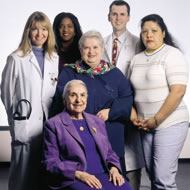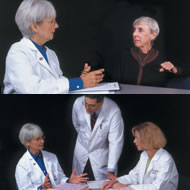Featured Initiative:

Hartford's Commitment to Team Care
Effective interdisciplinary teamwork has been shown to enhance quality
of care, improve patient safety, and reduce medication errors, while
making the duties of health care professionals more personally
rewarding and efficient. Yet evidence alone does not bring about
change in the large, well-entrenched health care system. Translating
study findings into clinical practice requires visionary leadership to
create and fund innovative, cost-effective models of care that become
widely accepted and adopted across the health care system.

 (Above) Students and faculty at the Houston Geriatric Interdisciplinary
Team Training [GITT] initiative meet to learn how to bring the combined
expertise of many health disciplines to support effective team care.
(Below) A Houston GITT team poses with their patient.
(Above) Students and faculty at the Houston Geriatric Interdisciplinary
Team Training [GITT] initiative meet to learn how to bring the combined
expertise of many health disciplines to support effective team care.
(Below) A Houston GITT team poses with their patient.
 Project IMPACT established the utility of an interdisciplinary model
incorporating medicine and nursing or social work to provide targeted
management of depression in older adults in the primary care setting.
Project IMPACT established the utility of an interdisciplinary model
incorporating medicine and nursing or social work to provide targeted
management of depression in older adults in the primary care setting.
For over two decades, the Foundation has funded initiatives aimed at improving care of older adults by incorporating interdisciplinary team care into professional education and clinical practice. The current team care initiatives build on past successful work that utilized an interdisciplinary team care approach.
The Acute Care for Elders (ACE) model, which was created by C. Seth Landefeld, MD, and colleagues, first funded in 1989, integrates geriatric assessment into the medical and nursing care of hospitalized older patients using interdisciplinary teams. ACE units are specialized units in the hospital that incorporate home-like features and encourage patients to be active and involved in their care.
Project IMPACT (Improving Mood-Promoting Access to Collaborative Treatment), launched in 1999, is an $11.1 million ground-breaking team model for late-life depression treatment in primary care. IMPACT demonstrated that team management of depression in primary care can improve the quality of life of elders in ways that are both practical and cost-effective.
The Generalist Physician initiative, which was funded in 1992, sought to improve primary care office practice by bringing health professionals such as nurses, social workers, and physician assistants into traditional physician care. From this initiative, the Foundation realized that improved academic training models were needed to prepare future professionals for interdisciplinary practice.
Education programs for health care professionals tend to follow strict disciplinary lines, leaving students unprepared for the work of facilitating and implementing patient care plans in an interdisciplinary setting. The Foundation's Geriatric Interdisciplinary Team Training (GITT) program, begun in 1995, focused on educating future health professionals (physicians, nurses, and social workers) to provide interdisciplinary care. GITT succeeded in demonstrating the feasibility of introducing formal education and training on geriatric teams into the education of health care professionals. GITT showed that even experienced professionals can improve their teamwork skills.
From the GITT initiative it became clear that training future professionals in team care was essential, but change must also take place at the system level. Most health care systems do not deliver care to older patients effectively or efficiently, in part because they do not make appropriate use of interdisciplinary teams. A 1999 report by Chad Boult, MD, MPH, MBA, and colleagues noted that the use of teams in innovative health care models “reflects the growing sense that chronically ill older people need additional expertise and structure in their health care,” but that relatively few health systems provide such care. They conclude that, “conditions are ripe to reward informed innovation in the care of chronically ill older people.”
The Geriatric Interdisciplinary Teams in Practice (GIT-P) initiative was first funded in June 2000 to support the creation and careful testing of innovative models of interdisciplinary team care. The overarching goals of this initiative were to (1) demonstrate the effectiveness of new models of interdisciplinary team care; (2) create exportable models, toolkits, and business plans that are compelling to the primary audiences of end adopters (namely payers, health care systems, and providers); and (3) promote wide-scale adoption of successful models.
Five sites were selected to conduct demonstration projects evaluating the clinical and financial impact of geriatric team care for five team models: 1) Care Transitions Intervention (University of Colorado Health Sciences Center); 2) Care Management Plus model (Intermountain Health Care and Oregon Health & Science University); 3) Senior Health and Wellness Clinic model (PeaceHealth Oregon Region); 4) Virtual Integrated Practice model (Rush University Medical Center); and 5) Senior Resource Team model (Group Health Cooperative). The findings from four of these projects were compelling and warrant a broad-based transfer of these models into new health care settings. The Senior Resource Team model was not successful, and therefore a case could not be made to move forward to a dissemination phase.
To facilitate the dissemination of the four models, in 2005 the Foundation awarded a three-year grant of $1,128,206 to the University of Colorado Health Sciences Center to lead the effort to promote the adoption of the models into practice nationwide. Rather than award individual dissemination grants to each site, the Foundation chose to structure the effort under one grant. The dissemination project is led by Eric Coleman, MD, MPH, Professor of Medicine, Divisions of Health Care Policy and Research and Geriatric Medicine, University of Colorado Health Sciences Center (UCHSC). Dr. Coleman is also the chief architect of one of the team care models-the Care Transitions Intervention.
 Case conferences at which medical professionals model team skills are
an integral part of Geriatric Interdisciplinary Team Training. Here, at New
York's Mount Sinai School of Medicine, the clinical team attends a daily
morning meeting at which care plans for patients with complex health
conditions are reviewed.
The coordinating center at UCHSC collaborates with project leaders to
develop an overall plan for promoting adoption of the models. By
bringing the models together under the umbrella of one dissemination
effort, the grantees can share results, learn from each other, take
advantage of economies of scale, and spread the word about each
other's projects. Key steps for ensuring successful adoption include
engaging senior management and clinical leadership, effective
presentation of process and outcome data, identifying an existing
infrastructure that can support adoption, and articulating how the
innovation responds to immediate and significant pressure in the
practice environment.
Case conferences at which medical professionals model team skills are
an integral part of Geriatric Interdisciplinary Team Training. Here, at New
York's Mount Sinai School of Medicine, the clinical team attends a daily
morning meeting at which care plans for patients with complex health
conditions are reviewed.
The coordinating center at UCHSC collaborates with project leaders to
develop an overall plan for promoting adoption of the models. By
bringing the models together under the umbrella of one dissemination
effort, the grantees can share results, learn from each other, take
advantage of economies of scale, and spread the word about each
other's projects. Key steps for ensuring successful adoption include
engaging senior management and clinical leadership, effective
presentation of process and outcome data, identifying an existing
infrastructure that can support adoption, and articulating how the
innovation responds to immediate and significant pressure in the
practice environment.
Grant funding is used for four activities:
- Prepare marketing and training materials
- Refine the business case for the models and help project staff to present them effectively to health care leaders
- Develop a common brand identity
- Cross-train investigators to serve as spokespersons for all models
All of the models continue to be strongly supported within their own
environments and have stimulated adoption in other settings. In 2005,
when the grant was awarded, the Foundation anticipated 20 early
adoptions by the end of three years. This goal was met in just one
year and by 2007 had been far exceeded.
Next Page: Team Care Models ›
